Questions and Answers: August 2014
We had several dozen questions with photos sent to us this month. Neil has selected the following questions to be of the widest reader interest. Click here to send Neil your question for the next e-gardens. Remember: he requires that a photo accompany your question.
Question: Do we need to worry about this plant? It’s getting ready to go to seed, and I’d rather not have anything invasive or dangerous. G. and G. L., DeSoto.
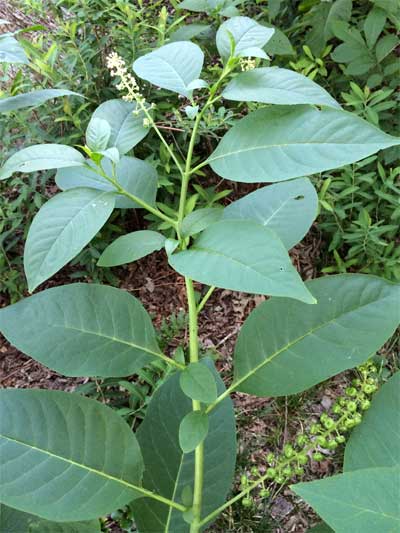
Answer: This is poke salad, a native Texas “wildflower” and weed. It’s actually very attractive while it’s growing in the garden, particularly when its fruit start to ripen. They are royal purple, and you can expect a lot more plants next year thanks to the help of your local birds. The plant is poisonous and should not be consumed. Here is a part of what the Lady Bird Johnson Wildflower Center has to say about it:
“… when we started research on your question, the first thing we found was an Alabama Cooperative Extension website, Don’t Eat Poke Salad. Then we went to our Native Plant Database page on Phytolacca americana (American pokeweed) and there are actually recommendations for cooking, although it also warns about the poisonous nature of the whole plant. Frankly, even though this is a part of American culture, we don’t think we’d want to touch it no matter how well it was cooked. Pokeweed is an alternative host for several plant viruses that feeding insects can transmit to other plants nearby. Since it is toxic both to humans and animals, it is considered a weed pest by many. We really can’t recommend eating this plant at all, and would recommend that it be removed from the area of other greens that you may be using for food.”
Question: I am having two large ash trees taken down and ground up. Is it safe to use the shreddings as a mulch for my xeriscaped yard? F.C., Bronte.
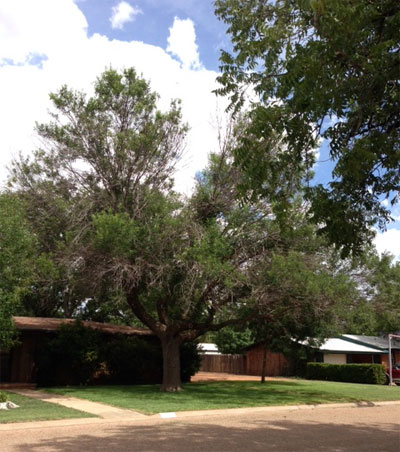
Answer: Yes. There is nothing in the wood of an ash tree that would cause problems to other plants in your garden. Do remember, however, that fresh chips can cause nitrogen deficiency when you mix them into the soil. Fresh bark mulch needs to stay on top of the ground.
Question: What can I use to keep root sprouts from coming up beneath my live oak? They keep coming back. Is there a barrier that would work? K.H., No city given.
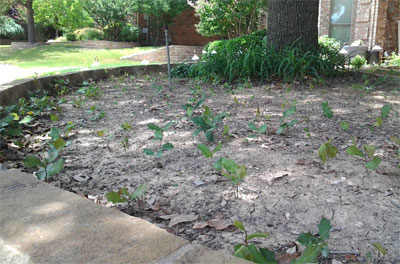
Answer: These are indeed sprouts from the tree’s roots, as opposed to seedlings. Any spray you might put on them could also damage the mother tree. You could consider using a landscape weed-blocking fabric to stop them, then conceal it with small river rocks or bark mulch. Hand-digging is the only way to get rid of these (use a sharpshooter spade), and they do indeed come back. This problem shows up in 10 to 15 percent of our live oaks.
Question: What causes these black spots on my live oak leaves? Is it anything about which I should worry? N.C., no city given.
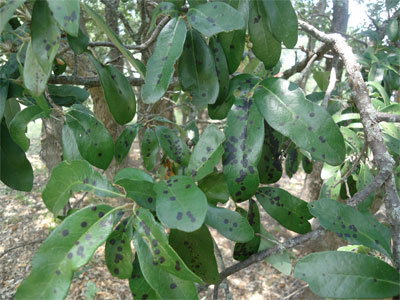
Answer: This is fungal, but I don’t think it’s going to be any long-term issue for you. You could apply a fungicidal spray to it, or you can just wait it out. It might be nice to have a sample run by the Texas Plant Clinic at Texas A&M, just to know if it’s anything to watch for next year.
Question: We have a bed of junipers against the property line. They are infested with bermudagrass and other weeds. How can we eliminate the weeds without harming the junipers? M.M., McKinney
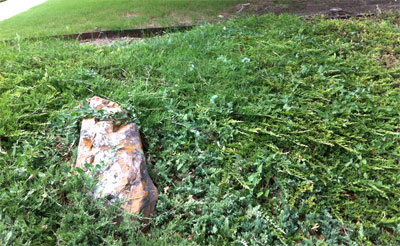
Answer: It would be difficult to spray. You can hand-treat with a glyphosate weedkiller spray trigger bottle to kill the bermuda, but you’ll need to use a piece of heavy cardboard to slide beneath the juniper and lift its branches off the ground long enough for you to spray the grass. Do not let the spray hit the juniper limbs. The other vine is a wild perennial morning glory relative, and it will have extensive roots in the soil – tougher than even the bermuda to eliminate. Cut pieces of roll-type landscape mulch, and slide them in beneath the shrubs. Overlap them by several inches to keep the weeds from being able to come up through the seams. I had the same issue with a bed of Tam junipers years ago, and I was able to get rid of both weeds in those ways. You should also drive the green edging farther into the soil. It ought to extend no more than 1/2 to 1 inch above the soil. That will prevent rhizomes (underground stems) from getting into the bed. As it is now, they can easily creep beneath it.
Question: We are allowed to water two times per week. I have very sandy soil. Is 40 minutes per station adequate for St. Augustine the balance of the summer? I also have lots of moles. Is there a way to get rid of them without using poisons? (I have pets and livestock.) L.McM., Springtown.
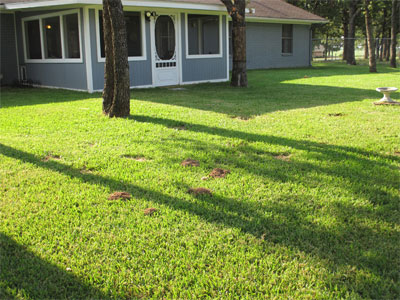
Answer: Each station on your controller will probably need to run a different length of time. It will depend on the type of vegetation, the type of head, sun or shade, etc. Your very best bet, and one that will pay for itself in short order, would be to install a “smart” controller that will help make that decision for you. For what it’s worth, Collin County, where I live and garden, is restricted to twice-a-month watering due to the rapid growth of population and insufficient water supply. It isn’t easy, but we’re trying to get through.
As for the moles, here is what I prepared for the FAQ section of my website:
“Moles have hairless, pointed snouts extending nearly 1/2 inch in front of their mouth openings. Their small eyes and the opening of their ear canals are concealed in fur, and there are no external ears. Moles are insectivores, related to bats. Moles are generally found in cool, moist and shaded soils that are populated by earthworms and grub worms. Moles leave volcano-shaped hills that are often made up of clods of soil. Moles are best controlled using traps that are implanted into depressed portions of the surface tunnels. As the moles push up to re-open their tunnels, the traps are triggered.”
Question: What are some good choices to replace our Japanese boxwoods? They look terrible after last winter’s cold. What can we do to help them recover? Or is it time to replace them? If so, what options would be best? No name or city given.
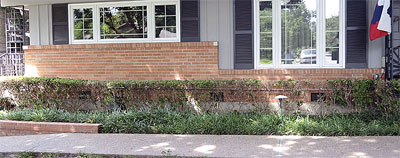
Answer: This planting will probably never look symmetrical again. I’d suggest using dwarf hollies. With four or five types in the market (dwarf Burford, dwarf yaupon, Carissa and dwarf Chinese, among others), you can create a nice change in appearance. Use clusters and groups, rather than repeating the long row. Giant liriope might be good, depending on where you live. Add in wood ferns in the shade, and you could have a really nice planting as early as this fall.
Question: I have crabgrass in my bermuda turf. Is there something I can apply to it now, to kill the crabgrass without harming my bermuda? R., Justin (Denton County).
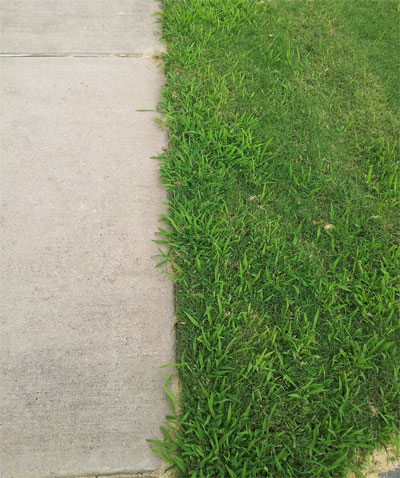
Answer: Sadly, no. When we lost MSMA several years ago, we also lost our only post-emergent herbicide to kill existing grassy weeds such as crabgrass and dallisgrass in bermuda. I’m taking you at your estimate that this is crabgrass. You need to apply either Halts or Dimension pre-emergents early next March in your part of Texas. Repeat the treatment 90 days later as a “booster shot.” If it turns out to be the perennial weed dallisgrass, you will have to dig it out by hand or apply a glyphosate weedkiller carefully only to the dallisgrass clumps. Try to get it identified soon so you’ll know your best plan of action. I can’t see it well enough on my monitor to tell which grass it is.”
Question: What might be going wrong with our tree? We were told it was a Japanese cypress, but we’re not sure that’s a correct ID. The lowest needles are turning reddish-brown. What should we do? L.H., 12 miles south of Alpine.
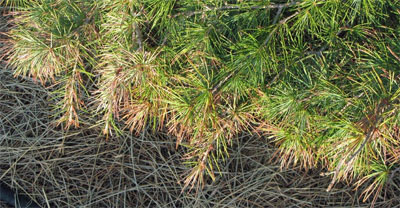
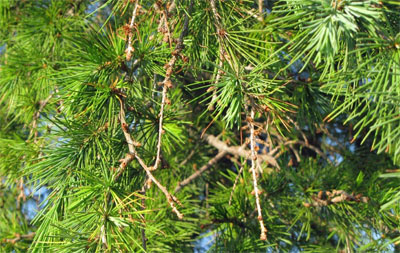
Answer: This looks like deodar cedar, and I would expect that the browning is due to low humidity and its getting too dry once in a while (in spite of your drip line). It looks like it must have done well for a period of time to get to this size. I would avoid fertilizer the balance of the summer. Keep it moist at all times. Hopefully the problem will stop. The problem does not appear to be insect- or disease-related.
(Surely wish I could trade places with you to be in the West Texas mountains. We enjoyed seeing snippets of the Sul Ross campus, Alpine and Big Bend at the end of the movie Boyhood a week ago!)
Question: What are these white eggs on our crape myrtle trunk? The trunks are covered with these, with ladybugs and with just plain flies. M. and J. L., Athens.
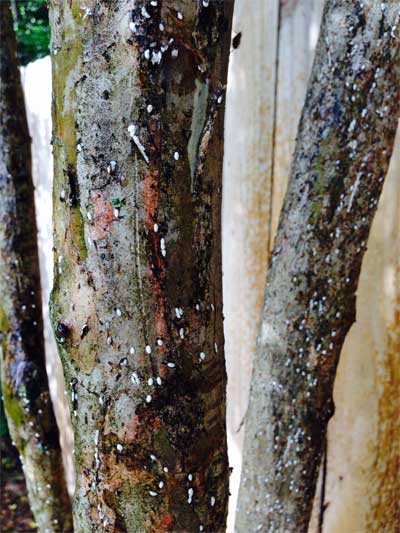
Answer: This is the “new” scale insect that was first reported in Collin County in 2004. Now identified as crape myrtle scale, it is an exotic pest that came from Southeast Asia. It basically is annoying but not especially harmful. The best news is that the ladybugs are very effective at eliminating it. Do not spray. Let them do the job of getting rid of the scales for you. Should any sticky honeydew exudate from the scales be left on the trunks, you may see a certain amount of black sooty mold growing in it. The mold, too, is only cosmetic. It will slough away as the bark peels and falls next spring.
Question: These crape myrtles were damaged by the cold, but I trimmed all of that out. The previous homeowner planted them, then topped them every year. I would prefer to let them grow as large as possible to give us some shade. How do I go about shaping them into attractive trees? M.H., Midland.
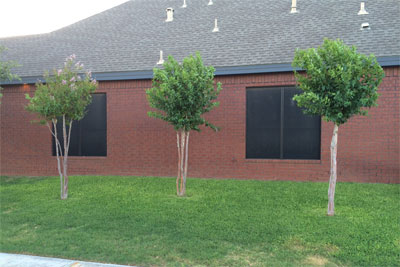
Answer: I can’t see how bad the stumps are within the leaf canopies. However, you could just let them go until winter and see how they look. They will grow quite rapidly, perhaps doubling their size in just a couple of years. If you decide that the stubs are too unsightly, your other option would be to cut them completely to the ground next February, then to train the re-growth back into tree forms. It sounds a lot worse than it really will be. Crape myrtles re-grow incredibly rapidly, since they have good root systems. You would be back in the game with lovely crape myrtle trees within a couple of years.
Question: I am debating whether I should remove this Bradford pear. I feel like it could split any day now. I also want to be able to grow St. Augustine in that area, and it’s currently quite shady. J., Richardson.
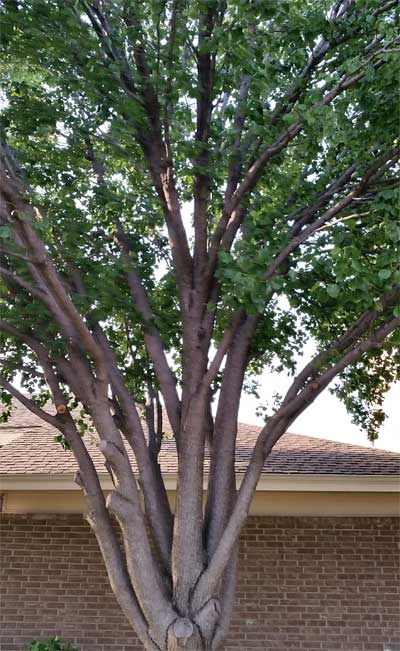
Answer: This baby is about to tumble. Those branches are incredibly pinched and weak due to their narrow branch angles. This tree could do thousands of dollars worth of damage if it were to split and fall onto your roof, etc.
Question: These are blackberry plants I moved from Plano to Central Texas. They are 6 years old, and they have been very poor producers since they were moved. What fertilizer should I use? What other maintenance do they need? K.G., Austin.
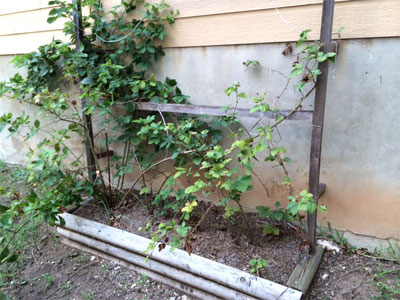
Answer: Prune blackberries in late spring/early summer, after they have finished any limited production they might have. Cut canes that were produced in the prior year (and that should have had fruit) completely to the ground. Apply an all-nitrogen lawn-type fertilizer after you trim them, and keep them moist at all times.
Question: What can I use to kill wild violets in my lawn? They are worst beneath a large pecan tree. They are crowding the St. Augustine out. J.L., Corsicana.
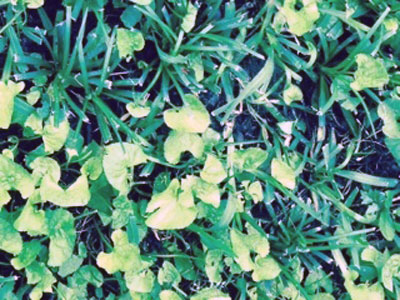
Answer: Every time I answer this by recommending a broadleafed weedkiller (2,4-D) spray, people get very upset that we are wanting to “kill wildflowers.” However, if they’re where you don’t want them, they become weeds. As you spray, you can improve your odds with one drop of liquid dishwashing detergent added per gallon of spray mix, to help the herbicide stay in place on the leaves without running off. For the record, it may be that shade is a worse enemy to your St. Augustine than the wild violets. While it’s our most shade-tolerant lawngrass, St. Augustine still needs four to six hours of direct sunlight daily.
Question: Why would this frangipani flower, when two others do not? This is the first year for this one to bloom. It was given to me by my late father, so it is very special to me. Any suggestions? J.N., no city given.
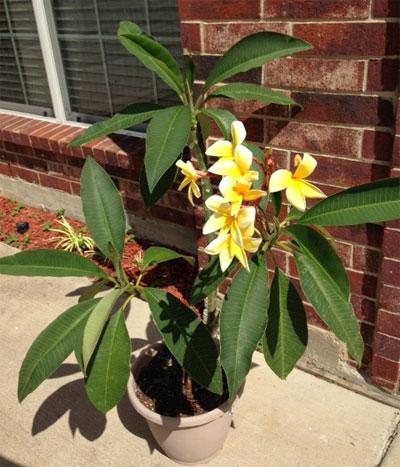
Answer: Plumerias need a certain amount of maturity to bloom well. This plant has gotten there, and perhaps the other two have not. Give them morning sun and shade in the afternoon, and be patient. What you’re doing for this one is obviously working.
Question: My oak tree is about 10 years old, and it is really struggling. It has a root growing around its trunk, plus the leaves are pale yellow. There are also bumps on the twigs. What can I do to help it? M.C., no city given.
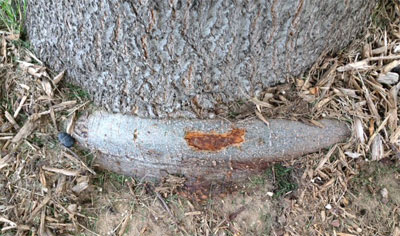
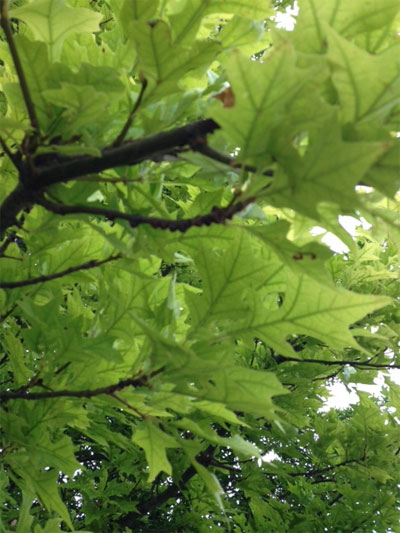
Answer: The root needs to be cut or chiseled, to keep it from girdling the trunk as the tree grows larger. As for the discoloration, that certainly looks like iron deficiency. It would have been really helpful in constructing my reply to know what part of Texas this tree is growing in. With iron deficiency that serious, I suspect you’re in an area that has alkaline soils, and I’d be willing to bet that this is not a true Shumard red oak, but indeed a pin oak (Quercus palustris). The bumps are scale insects. I can see them (I believe) on the twigs. They are probably not doing much to damage the tree at this point, but you may still want to spray with a labeled insecticide or apply a systemic insecticide next spring.
Question: Is it possible for crape myrtles to be too crowded? This is the landscape of one of my customers, and the plants have looked like this for all eight or nine years that I’ve been mowing for them. I think they might be overwatered, but I’m just not sure. A.R., Seguin.
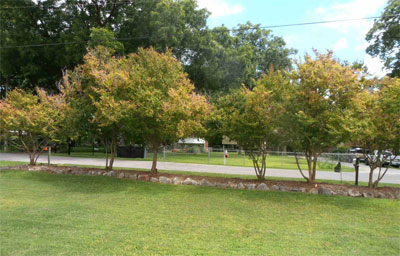
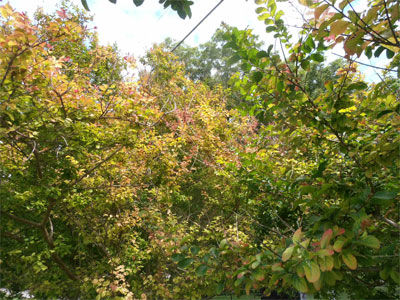
Answer: From a distance, these look like they’re suffering iron deficiency. However, that’s rather unusual, and it would only happen if the soils were highly alkaline or if there were some reason that roots had been damaged (gas leak, weedkiller injury, or, as you mentioned, overly wet soils). It would probably be worth investing in a basic soil test that would show levels of the primary nutrients, also pH and soluble salts. High levels of phosphorus, for example, can lead to plants’ inability to take up minor elements. Crape myrtles do quite well in Houston and across the Gulf Coast, so unless the water table is near the soil surface, I don’t think that is a likely cause of the problem. If this were my customer, I’d have the soil test run at Texas A&M (contact your local Extension office) and find out those results first. Then you would know whether to apply a trace-elements fertilizer, iron alone or perhaps something else. Please let me know what you find out. Good luck! Hope this helps get it corrected.
Question: My gorgeous ‘Traveller’ weeping redbud is being eaten, and I found these cocoons hanging from the twigs. I treated for snails, as I found two on the tree. I also found one grasshopper. What should I do? J., Malakoff.
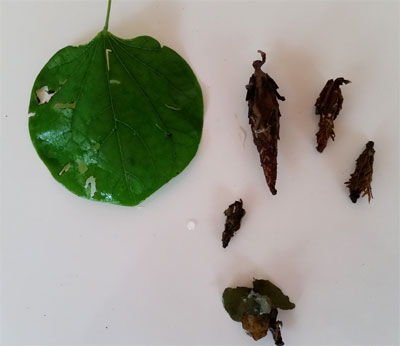
Answer: These are bagworms, the same as those that hit junipers, arborvitae and cedars. These, however, ran off-course and ended up on a plant species that is definitely not one of their preferred host plants. Hand-picking is probably all you will need to do. Grasshoppers should not present a problem unless you have a huge population of them, and snails will not climb this high on a tree — at least not in numbers sufficient to do any damage of this magnitude.
Question: What is this on my red oak’s leaves? Another red oak nearby is unaffected. M.T., Grayson County.
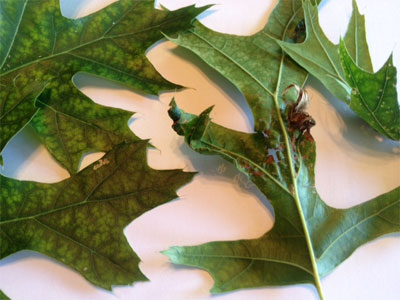
Answer: This is an insect gall. Oaks in general have hundreds of types of galls. They are basically harmless. The adult of an insect species stings the leaves and deposits eggs. The gall tissue is produced by the plant around the eggs. There is no preventive treatment, nor is there a way to eliminate them once they are there. Some years will be worse than others. No call to action.
Question: This mature Shumard red oak was greatly damaged during last year’s freeze and has strangely lost at least one major branch every summer for the past few years. I was recommended to consider a Paclobutrazol treatment for the tree to maintain its current size and improve its overall health. My research of Aggie horticulture online barely references this chemical treatment on anything except smaller plants. Your expertise is much appreciated! K.Y., Richardson, TX
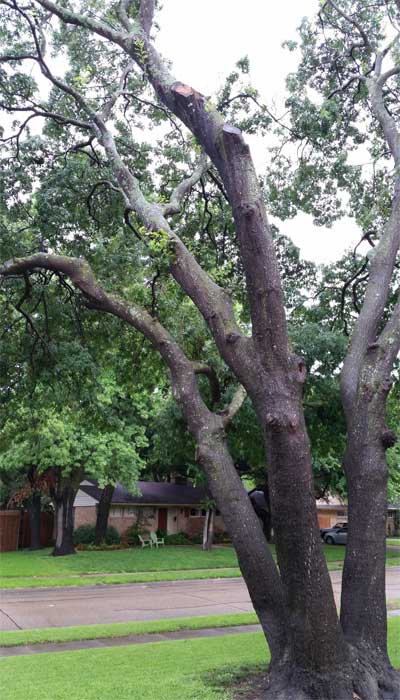
Answer: When I contacted our friends at Arborilogical Services, certified arborist Bill Seaman provided me with this information:
(Thanks, Bill!)
“Paclobutrazol became a mainstream growth regulator for trees when theme parks found they could use it to reduce the pruning cycles for trees and shrubs and virtually “freeze” the look of a tree once it reached the desired size. This is a valuable arborist tool when caring for properties that are full of people — all day, every day. As a growth regulator, it reduces shoot growth so new leaves are compact and dense. Additional research found that it can significantly increase the volume of fine roots, so it also became an arborist’s tool to generate new fibrous tree roots for trees that would have their root systems compromised as a result of construction. There are numerous other benefits. A more common current use in urban landscapes is to check the growth of mature trees near electrical power lines, reducing the frequency for line clearance pruning. Paclobutrazo can be a very useful tool for managing tree health, but it should only be used under the eye and management of a certified arborist.”
